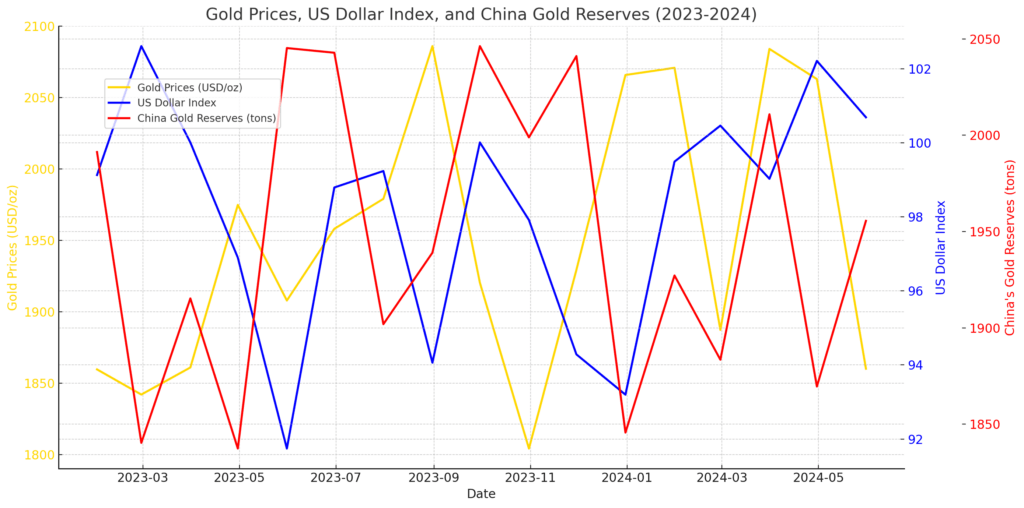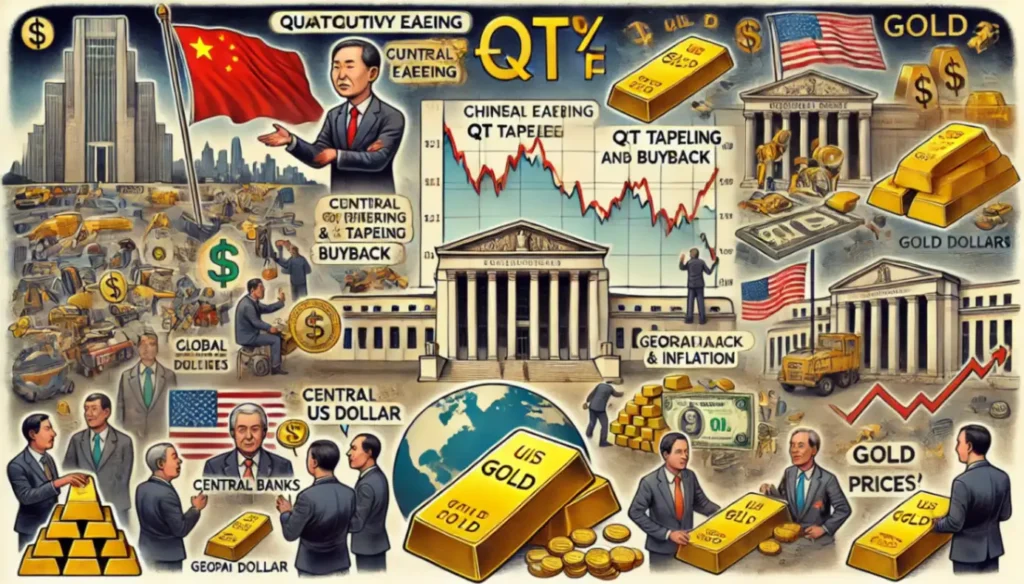Gold Price Analysis and Future Outlook
Current Gold Price Trends
As of June 2024, gold prices are trading between approximately $1,950 and $2,000 per ounce. This range reflects the volatility caused by recent economic uncertainties and changes in financial policies among major economies. Additionally, since the 2008 financial crisis, continuous low-interest rate policies and quantitative easing across major and emerging markets have increased the money supply, leading to a depreciation in currency value and a significant rise in demand for gold, which is considered a safe and easily liquidated asset.

- The following graph shows changes in gold prices, the U.S. Dollar Index (DXY), and China’s gold reserves from 2023 to June 2024.
- Gold Prices (USD/oz): Fluctuated between $1,800 and $2,100 per ounce.
- U.S. Dollar Index: Fluctuated between 90 and 105, with a recent downward trend.
- China Gold Reserves (tons): Fluctuated between 1,800 and 2,100 tons, showing a continuous upward trend.
Analysis of Factors Driving Gold Price Increases
1. Increased Gold Purchases by China
Between late 2023 and early 2024, the People’s Bank of China purchased over 300 tons of gold. This move is seen as part of a strategy to increase the proportion of gold in China’s foreign exchange reserves. Amid worsening relations with the United States and sanctions on Chinese products across various sectors, China has sought to bolster its domestic market through various self-reliant measures. Increasing gold reserves serves as a means to reduce reliance on the U.S. dollar, hedge against its volatility, and enhance the value of the yuan, thereby driving up international gold prices.
2. China’s Quantitative Easing
In early 2024, the People’s Bank of China injected an additional 1 trillion yuan of liquidity into the market. This action came as the U.S. increased economic pressure on China across various sectors, such as automotive, steel, and IT. Additionally, with Xi Jinping’s permanent presidency now officially confirmed, there has been a significant rise in the exodus of economic, academic, and political leaders from China.
To counteract the downturn in the domestic market, the Chinese government has implemented unprecedented quantitative easing policies, greatly increasing market liquidity. This liquidity surge has boosted domestic demand for gold, significantly contributing to the global rise in gold prices. This trend is particularly relevant as gold is favored as a safe asset amid efforts to boost liquidity to help the Chinese economy recover from a slowdown.
3. U.S. QT Tapering and Buybacks
During the first half of 2024, the U.S. Federal Reserve purchased approximately $50 billion worth of Treasury bonds, injecting liquidity into the market. This move aligns with the upcoming U.S. presidential election, where maintaining high-interest rates while significantly increasing dollar liquidity aims to turn economic indicators positive and stimulate the economy.
The Federal Reserve’s buyback program increases market liquidity, supporting gold prices. Continuous dollar liquidity injection leads to inflation, causing a sharp decline in the dollar’s value and increasing gold demand as a hedge. This trend boosts investors’ interest in gold, particularly amid potential interest rate cuts.
4. China’s Ultra-Long-Term Bond Issuance
In May 2024, the Chinese government issued ultra-long-term bonds with a 50-year maturity worth 1 trillion yuan. Issuing such ultra-long-term bonds is unusual and signals a significant increase in money supply.
This issuance promotes gold demand among investors seeking stable investment options, potentially leading to long-term gold price increases and signaling a decline in currency value.
5. Global Economic Uncertainty
Global economic uncertainty persists amid geopolitical tensions and inflationary pressures. Recent events such as the Ukraine crisis and U.S.-China trade disputes have significantly heightened these uncertainties.
Economic uncertainty drives investors to prefer gold as a safe asset. During the COVID-19 period, the cryptocurrency market showed high volatility. While some investors achieved significant gains, others suffered substantial losses. Demand for gold, as a safer and relatively high-yield investment, has been increasing among institutional and individual investors.
6. Value of the U.S. Dollar
During the first half of 2024, the U.S. Dollar Index (DXY) fell by 5%. Since the onset of COVID-19, inflation has continued to rise annually.
Gold prices typically have an inverse relationship with the dollar. When the dollar weakens, gold prices tend to rise. The recent decline in the dollar has supported the increase in gold prices.
7. Central Bank Gold Reserves
Several major central banks have significantly increased their gold reserves in 2024. Russia and India, facing ongoing geopolitical instability, have emerged as major gold purchasers.
As the Petra policy, in place for over 50 years, is disrupted and the dollar weakens, central banks in major countries continue to increase their gold reserves. This trend is a significant factor contributing to rising gold prices.

Future Outlook
Gold prices are expected to rise over the long term. Continued global economic uncertainty and the steady demand for gold as a safe haven asset suggest sustained price increases. China’s gold purchases, quantitative easing policies, and U.S. liquidity injections will continue to support gold prices. As currency values decline rapidly, holding cash results in asset losses, likely increasing demand for gold and real estate.
However, U.S. interest rate hikes could negatively affect gold prices. Despite this, the factors supporting gold price increases are more substantial, and gold prices are expected to rise steadily over the next decade.
Conclusion
Gold prices have consistently risen due to geopolitical instability, U.S.-China conflicts, high inflation, and other complex factors. Currently, gold prices remain relatively high amid global economic uncertainty. This trend will likely continue, with gold prices expected to rise steadily over the next decade. Allocating 15% of an investment portfolio to gold assets could yield stable and high returns.